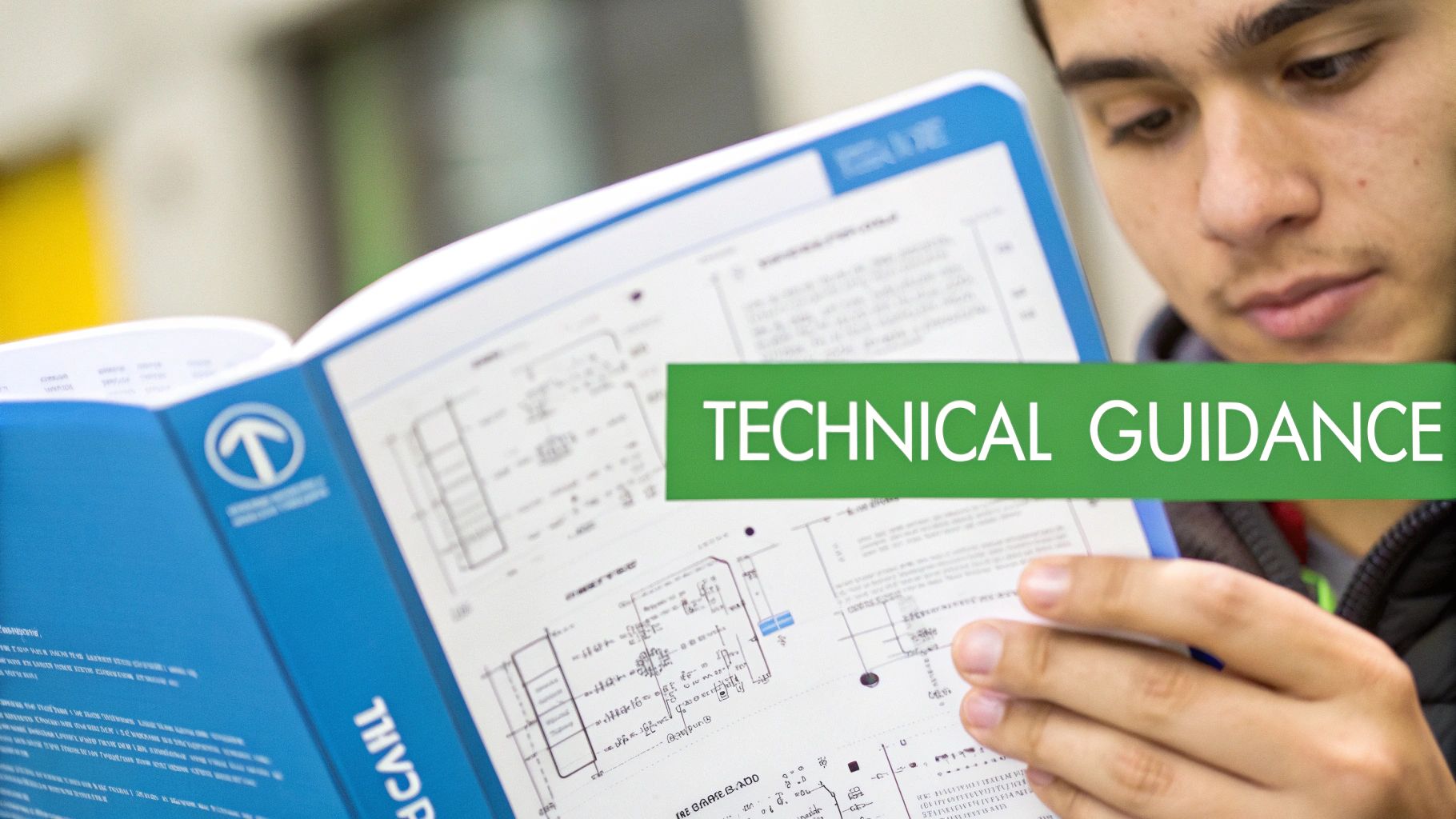Breaking Down Technical Communication Fundamentals

Technical communication is about more than just explaining complex topics - it’s about strategically crafting information for specific audiences. When writing technical content, you need to carefully consider your language choices, use visual elements effectively, and select the right format to reach your readers. A software user manual requires a completely different approach than an engineering report. Understanding these audience differences is essential for communicating technical information successfully.
Key Elements of Effective Technical Communication
Creating high-quality technical content relies on several core principles that ensure information is accurate, accessible and useful for readers.
- Clarity and Conciseness: Choose precise words and avoid unnecessary jargon to help readers quickly grasp your message. Think of giving directions - short, clear instructions work better than long-winded explanations. Clear writing helps readers find what they need without getting lost in unnecessary details.
- Audience Focus: Your readers’ technical expertise level, needs, and expectations should shape your writing style and content. An experienced developer needs different details than someone new to the software. Understanding your audience helps you provide the right information in the right way.
- Purpose-Driven Communication: Every piece of technical writing needs a clear goal - whether it’s to teach, inform, convince, or document something. This goal guides what you include and how you structure it. A tutorial focuses on step-by-step instructions, while a white paper aims to make a case for a particular approach.
- Strategic Design: Visual elements like headings, lists, and graphics make complex information easier to understand. They break content into manageable pieces and help readers navigate to what’s important. Good design isn’t just about looks - it’s about making information more accessible. These elements work together as an integrated system. When one part is missing, it affects how well the whole piece communicates.
The Evolving Role of Technical Communicators
Technical communication has grown far beyond basic documentation. Today’s technical writers shape user experience, drive product adoption, and contribute directly to business success. They create content across many formats - from traditional guides to interactive tutorials and help systems. The field keeps growing as new tools and communication methods emerge. You might be interested in: How to master technical documentation.
As products and services become more complex, skilled technical communicators are more important than ever. They bridge the gap between technical experts and everyday users by translating complex concepts into clear, useful information. This ability to make technical details accessible and understandable directly impacts how successful a product will be with its users. The need for effective technical communication continues to grow as technology becomes more integrated into our daily lives.
Mastering Modern Technical Content Formats

Creating effective technical content today requires more than just understanding basic principles. The real challenge lies in applying those principles across different content formats that resonate with modern audiences. Each format serves a specific purpose and meets distinct user needs. Static documentation no longer suffices - technical communicators must now create engaging content that works across multiple channels and platforms.
Choosing the Right Format for Your Audience
Knowing your audience is essential for selecting the most effective content format. For instance, a developer working on API integration needs detailed technical specifications through clear API documentation or a structured knowledge base. In contrast, a non-technical user setting up the same software might learn better from step-by-step visual guides or video walkthroughs. The key is matching the format to how your audience prefers to consume information.
Context also plays a vital role in format selection. Someone quickly checking information on their phone might prefer short FAQ answers, while a user doing deep research at their desk could benefit more from an in-depth white paper. When you provide information in formats that match how people actually use it, they’re more likely to understand and apply it successfully.
Content Formats in Action
Modern technical content comes in many forms, each serving different purposes:
- Interactive Knowledge Bases: Self-service information hubs that help users find answers quickly without contacting support
- API Documentation: Essential developer resources that explain how to work with software interfaces correctly
- Video Tutorials: Step-by-step visual guides that make complex processes easier to follow
- Infographics and Data Visualizations: Clear visual breakdowns that help readers grasp complex information quickly
- Podcasts and Webinars: Audio content that lets users learn while multitasking This mix of formats helps technical writers reach different types of learners effectively, improving how well users understand and retain information.
Maintaining Consistency and Measuring Performance
While offering various content formats is important, keeping a consistent style across all of them builds trust and helps users navigate more easily. Using the same terms, tone, and branding across different formats creates a smooth experience for users moving between different types of content.
But creating good content is just the first step - you also need to know if it’s working. Looking at metrics like how long people spend reading pages, which content they view most, and what feedback they give shows what’s actually helping users. This data helps you improve your content strategy over time. By watching how users interact with different formats, you can keep adjusting your approach to better meet their needs.
Building Your Technical Communication Toolkit

Writing great technical content requires more than just understanding different formats - you need the right combination of skills and tools. Technical writers who excel at their craft blend deep technical knowledge with clear communication abilities. For example, when documenting a complex software feature, a writer needs to understand both the technical implementation details and how to explain them in terms that make sense to the end user.
Essential Skills for Technical Communicators
To create effective technical content, writers need several key skills beyond technical expertise:
- Analytical Thinking: Breaking down complex topics into clear, logical pieces helps writers identify and communicate core concepts effectively. This skill lets you spot what’s most important and present information in a structured way.
- Empathy: Understanding your readers’ needs and knowledge level helps you create content that truly helps them. By putting yourself in their shoes, you can address their questions before they even ask them.
- Collaboration: Technical writers regularly work with developers, designers, product managers and other specialists. Strong teamwork skills help you gather accurate information, incorporate different perspectives, and maintain consistency across documentation.
- Adaptability: New tools and technologies emerge frequently in technical communication. Being able to learn quickly and adjust your approach helps you stay effective as requirements change.
Tools to Enhance Your Workflow
The right tools make a big difference in how efficiently you can create and manage documentation. This lets you focus more on writing quality content instead of administrative tasks. Here are some essential tools to consider:
- Documentation Generators: Tools like DocuWriter.ai help automatically create API and code documentation with consistent formatting and structure. This automation saves time you can spend on more complex writing tasks.
- Grammar and Style Checkers: These tools catch errors and inconsistencies that are easy to miss during writing. Using them alongside a clear style guide helps maintain professional quality across all documentation.
- Content Management Systems: Having one central place to store and organize documentation makes it much easier to find, update and share content. This organization is key for maintaining consistency as your documentation grows.
- Collaboration Platforms: Tools that make it simple for team members to review and comment on documentation help streamline the editing process. They allow you to efficiently collect and incorporate feedback from different stakeholders.
Building a Scalable Workflow
As your documentation projects grow larger, having clear processes becomes even more important. Start by mapping out each step from initial research through final publication. This helps you stay organized and use your time well. Make sure to include regular review cycles to maintain quality and consistency. By continually improving your workflow based on what you learn from each project, you can keep your documentation process running smoothly even as complexity increases.
Creating Content for Global Audiences

Technical communication has no borders. When writing technical content, we must ensure it resonates with readers worldwide, regardless of their native language or cultural background. Creating clear, accurate, and culturally-sensitive content requires specific skills and approaches. Let’s explore how to develop technical documentation that works effectively across different cultures and languages.
Understanding the Global Landscape
With billions of people accessing online content daily in countless languages, technical writers face unique challenges in reaching international audiences. A software manual, for instance, needs to make sense to users in Tokyo just as much as those in São Paulo. This means going beyond basic translation to truly understand how different cultures process and interpret information. Writers must consider how concepts, examples, and instructions translate across linguistic and cultural boundaries.
Strategies for Creating Globally Effective Content
Making content work across multiple languages and cultures starts with smart planning from day one. Here are key approaches that successful technical writers use:
- Internationalization: Design your content so it can adapt easily to different locations without major structural changes. This means keeping text separate from code, using Unicode for text encoding, and making sure all elements that might need local adaptation are easily accessible.
- Localization: This step goes deeper than translation. It’s about making your content feel natural in each target market. This includes adapting graphics, adjusting how dates and numbers appear, and being mindful of cultural preferences. For example, a color that signifies good luck in one culture might mean something entirely different in another.
- Accessibility: Make sure everyone can access your content, including users with disabilities. Add alt text to images, include video captions, and ensure keyboard navigation works throughout. Following WCAG guidelines helps make technical documentation accessible to all users.
Maintaining Quality Through Localization
Quality control during localization requires careful attention to detail and the right partnerships.
- Choosing the Right Localization Partner: Work with professionals who know both the technical subject matter and target culture inside out. They should excel at translating complex terminology while preserving meaning within local cultural contexts.
- Thorough Quality Assurance Testing: Put a strong QA process in place. Test both language accuracy and technical functionality. Local reviewers can offer invaluable feedback about whether content feels natural and appropriate for their market.
Cultural Considerations and Regulatory Compliance
Cultural differences shape how people interpret technical information. Some readers prefer direct instructions, while others respond better to a more diplomatic approach. Beyond culture, different countries have specific rules about language use and data privacy. Technical writers must stay current with these regulations to keep content compliant and effective.
By paying attention to these details, technical communicators create documentation that works well for diverse audiences. This careful approach helps build trust with users worldwide, improves their experience, and contributes to the success of products in global markets.
Navigating Technical Communication Careers
The field of technical communication blends writing skills with deep technical knowledge and expertise in user experience. From software documentation to medical writing, technical communicators work across many industries and formats to make complex information clear and accessible. As companies increasingly need to explain their products and services effectively, opportunities in this field continue to expand. Let’s explore what it takes to build a successful career in technical communication.
Exploring Career Options
Technical communication offers many paths depending on your interests and strengths. As a technical writer, you might create user manuals that help people understand new software, write API documentation for developers, or develop white papers explaining complex technologies. If you enjoy focusing on digital experiences, you could work as a UX writer crafting the words users see in apps and websites. Other professionals choose to become instructional designers developing training materials, or medical writers creating healthcare documentation and patient resources. The variety means you can align your career with topics you find engaging while putting your communication skills to work.
Building a Strong Foundation
Success in technical communication starts with demonstrating your capabilities through a strong portfolio. Include examples of your best work - whether that’s user guides, help documentation, or other technical content you’ve created. Getting involved in the technical communication community is equally important. Join professional organizations, attend industry events, and participate in online discussions. These connections often lead to mentoring relationships, collaboration opportunities, and job prospects as you advance in your career.
Developing Essential Skills
Clear writing forms the foundation, but technical communicators need several key abilities to succeed. Sharp analytical skills help you break down complex topics into clear, logical explanations. Picture explaining how to use a new smartphone feature to someone who has never used one before - you need to understand both the technology and your audience’s perspective. Being able to put yourself in your readers’ shoes helps you create content that truly meets their needs. The field also requires ongoing learning as new tools and platforms emerge. Staying curious and adaptable ensures you can grow along with changes in technology and communication methods.
Salary Expectations and Career Growth
According to the Bureau of Labor Statistics, technical writer employment is growing faster than average, with an 11 percent increase projected from 2016 to 2026. This reflects the ongoing need for professionals who can explain technical concepts clearly. While salaries vary by location, experience level, and specialty, the BLS reports that technical communicators earn competitive wages with room for growth. As you gain expertise, you can focus on high-demand areas like API documentation, UX writing, or medical writing. Building your skills strategically and staying current with industry trends positions you well for long-term success in this rewarding field.
How Technology Is Changing Technical Communication
As digital tools advance, technical communication is moving beyond traditional static manuals into more dynamic, interactive formats. Writers now create documentation using tools and methods that engage users in new ways - like hands-on tutorials that let people learn by doing rather than just reading. This fundamental shift means we need to look at technical communication through a fresh lens.
Key Technologies Shaping the Field
Several important technological developments are changing how technical communicators work:
- AI Writing Assistants: Tools like DocuWriter.ai now help generate initial drafts of code documentation and API guides. This frees up writers to focus on creating richer content like in-depth tutorials. The AI handles routine tasks while humans add strategic value.
- Interactive Learning Elements: Rather than static text, modern documentation often includes simulations, knowledge checks, and choose-your-own-path scenarios. This hands-on approach helps users learn in ways that work best for them, at their own speed.
- User Behavior Analytics: By studying how people actually use documentation, writers can now see what’s working and what isn’t. This data helps them continuously improve content to better serve user needs.
- AR and VR Solutions: These technologies create immersive learning experiences that are especially helpful for complex technical training. Users can practice procedures in a realistic but safe virtual environment.
Making Smart Technology Choices
While new tools offer exciting possibilities, technical communicators need to be thoughtful about which ones to adopt. Not every new technology will be the right fit. Here are key questions to consider:
- Does it support your communication goals? For example, if you need to explain a complex process, an interactive simulation might work better than static diagrams and text.
- Will it work smoothly for users? Even powerful features aren’t helpful if they get in the way of a smooth user experience.
- Is it worth the investment? Look for clear benefits like faster content creation, happier users, or fewer support tickets before committing to new tools.
The Essential Human Element
Even as automation increases, skilled technical communicators remain essential. While AI can generate basic content, it can’t replace human judgment, empathy and creativity. Instead of being replaced, technical communicators are becoming strategic content designers who:
- Shape the overall user experience
- Ensure content meets user needs
- Guide and verify AI-generated material
- Align documentation with company voice and goals Technical communication continues to evolve with new technologies. The key is thoughtfully adopting helpful tools while staying focused on clear, accurate, user-centered content. Want to see how AI can help streamline your documentation process? Check out DocuWriter.ai to learn more.